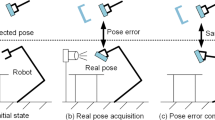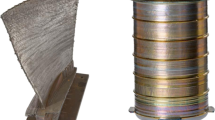Abstract
Intelligent and accurate determination of the position and orientation, or pose, of a workpiece which is manually placed is essential for automating fabrication tasks such as welding. In this paper, a novel algorithm based on minimizing the area of a boundary enclosing partial scan data points is proposed for detecting both the pose and assembly of tubular joints with the aid of reference ideal models. The proposed algorithm can also be applied to tubular joints with non-cylindrical cross sections. The fit-up information obtained can be used to determine whether realignment is required or combined with the pose information to re-plan paths for subsequent tasks. The focus of existing state-of-the-art is on objects with features, and the localization of featureless objects such as generic tubular joints using partial and sparse scan data remains a challenge. The proposed algorithm is applied to an actual robotic welding system to locate a tubular workpiece. Experiment results using the scan data as ground truth show that root mean square error is less than 1% of the pipe diameters, considering both brace and chord components with diameters greater than 200 mm.




















Similar content being viewed by others
Explore related subjects
Discover the latest articles and news from researchers in related subjects, suggested using machine learning.References
Song HC, Song JB (2013) Precision robotic deburring based on force control for arbitrarily shaped workpiece using CAD model matching. Int J Precis Eng Manuf 14(1):85–91
Zhu LM, Xiong ZH, Xiong YL (2004) A distance function based approach for localization and profile error evaluation of complex surface. IEEE Trans ASME 126(3):542–554
Sun Y, Xu J, Guo D, Jia Z (2009) A unified localization approach for machining allowance optimization of complex curved surfaces. Precis Eng 33(4):516–523
Chen XZ, Chen SB (2010) The autonomous detection and guiding of start welding position for arc welding robot. Ind Robot Int J 37(1):70–78
Rajaram M, Dawson-Haggerty M, Shimada K, Bourne D (2013)Automated workpiece localization for robotic welding. In: Proceedings of 2013 IEEE international conference on automation science, pp 681–686, Madison, WI, USA, August 17–20
Castro MD, Vera JC, Ferre M, Masi A (2017) Object detection and 6D pose estimation for precise robotic manipulation in unstructured environments. In: Proceedings of 2017 international conference on informatics in control, automation, and robotics, pp 392–403, Madrid, Spain, July 26–28
Zou Y, Chen J, Wei X (2020) Research on a real-time pose estimation method for a seam tracking system. Opt Lasers Eng 127:105947
Lin B, Wang F, Zhao F, Sun Y (2018) Scale invariant point features (SIPF) for 3D point clouds and 3D multi-scale object detection. Neural Comput Appl 29:1209–1224
Wang Y, Solomon JM (2019) Deep closest point: learning representations for point cloud registration. In: Proceedings of IEEE international conference on computer vision (ICCV), pp 3523–3532, Seoul, South Korea, October 27–November 2
Qi CR, Su H, Mo K, Guibas LJ (2017) Pointnet: deep learning on point sets for 3D classification and segmentation. In: Proceedings of the IEEE conference on computer vision and pattern recognition (CVPR), pp 652–660, Honolulu, Hawaii, USA, July 21–26
Wang Y, Sun Y, Liu Z, Sarma SE, Bronstein MM, Solomon JM (2019) Dynamic graph CNN for learning on point clouds. ACM Trans Graph 38(5)
Yang J, Li H, Campbell D, Jia Y (2016) Go-ICP: a globally optimal solution to 3D ICP point-set registration. IEEE Trans Patten Anal Mach Intell 38(11):2241–2254
Yang J, Cao Z, Zhang Q (2016) A fast and robust local descriptor for 3D point cloud registration. Inf Sci 346–347:163–179
Aoki Y, Goforth H, Srivatsan R. A., Lucey S, (2019) PointNetLK: robust and efficient point cloud registration using PointNet. In: Proceedings of the IEEE conference on computer vision and pattern recognition (CVPR), pp.7163–7172, Long Beach, California, USA, June 16–20
Sarode V, Li X, Goforth H, Aoki Y, Dhagat A, Srivatsan RA, Lucey S, Choset H (2019) One framework to register them all: PointNet Encoding for Point Cloud Alignment, arXiv, Vol. 1912.05766
Yang H, Shi J, Carlone L (2021) TEASER: fast and certifiable point cloud registration. IEEE Trans Rob 37(2):314–333
Nasser B, Rabani A (2019) An Advanced Method for Matching Partial 3D Point Clouds to Free-Form CAD Models for In-Situ Inspection and Repair. In:Proceedings of the automated visual inspection and machine vision III, pp 1106105, Munich, Germany, June 24–27
Ahmed SM, Tan YZ, Lee GH, Chew CM, Pang CK (2016) Object detection and motion planning for automated welding of tubular joints. In: Proceedings of 2016 IEEE/RSJ international conference on intelligent robots and systems, pp 2610–2615, Daejeon, Korea, October 9–14
Chen X, Dharmawan AG, Foong S, Soh GS (2018) Seam tracking of large pipe structures for an agile robotic welding system mounted on scaffold structures. Robot Comput Integr Manuf 50:242–255
Tan YZ, Fang Q, Pang CK, Al-Mamun A, Wong FS, Chew CM (2018) Precise detection of pose and assembly error based on partial scan data for fabrication of tubular joints. In: Proceedings of 2018 international conference on advanced robotics and mechatronics, Singapore, July 18–20
Kjer HM, Wilm J (2010) Evaluation of surface registration algorithms for pet motion correction. Bachelor thesis, Informatics and Mathematical Modelling, Technical University of Denmark, Kongens Lyngby, Denmark
Besl PJ, McKay ND (1992) A method for registration of 3D shapes. IEEE Trans Pattern Anal Mach Intell 14(2):239–256
Acknowledgements
The authors thank the National Research Foundation, Keppel Corporation and National University of Singapore for supporting this work done in the Keppel-NUS Corporate Laboratory. The conclusions put forward reflect the views of the authors alone and not necessarily those of the institutions within the Corporate Laboratory.
Author information
Authors and Affiliations
Corresponding author
Ethics declarations
Conflict of interest
The authors declare they have no conflict of interest.
Additional information
Publisher's Note
Springer Nature remains neutral with regard to jurisdictional claims in published maps and institutional affiliations.
Rights and permissions
About this article
Cite this article
Tan, Y.Z., Pang, C.K., Al Mamun, A. et al. Precise pose and assembly detection of generic tubular joints based on partial scan data. Neural Comput & Applic 34, 5201–5211 (2022). https://doi.org/10.1007/s00521-021-06246-6
Received:
Accepted:
Published:
Issue Date:
DOI: https://doi.org/10.1007/s00521-021-06246-6




